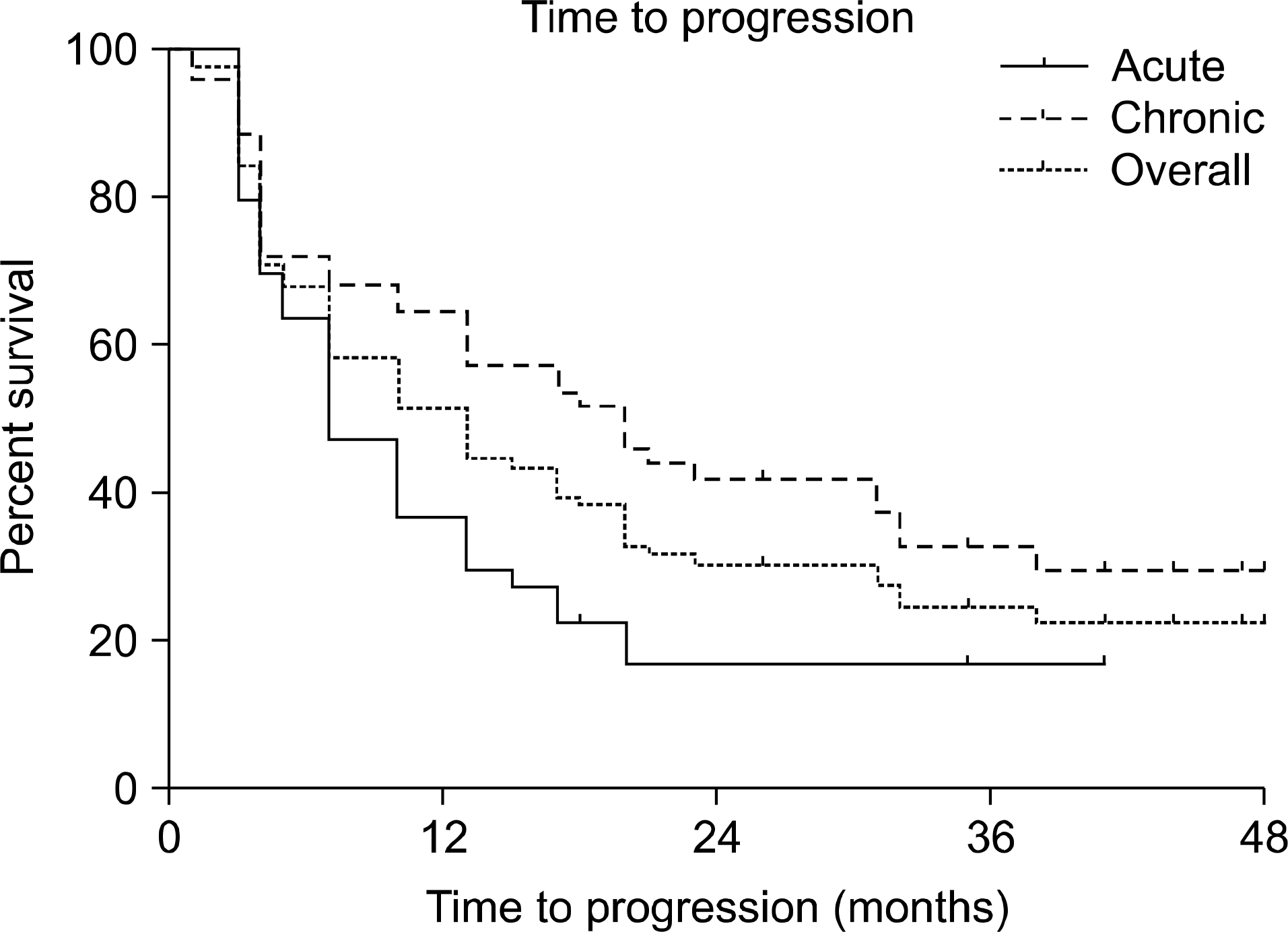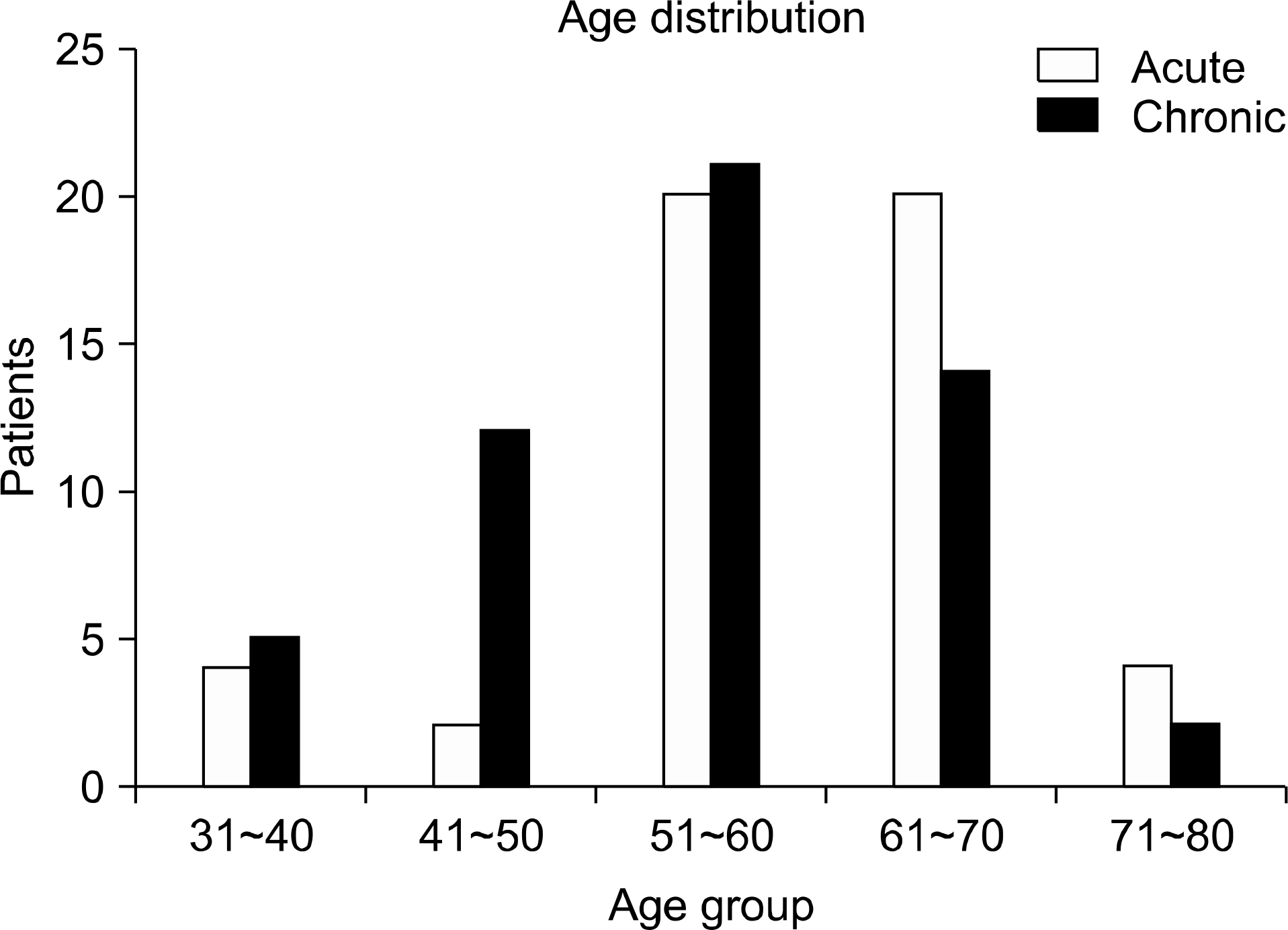Abstract
Purpose
Medical treatment of Peyronie's disease with tamoxifen has been initially proposed as acting upon the early phase of the disease. As recent reports show no significant benefit of tamoxifen, we review the long term results of tamoxifen treatment of Peyronie's disease.
Conclusions
Tamoxifen showed no significant benefit in slowing the progression of Peyronie's disease in the acute phase over the chronic phase. Peyronie's disease continued to progress, though at a dampened rate for patient's in the chronic phase.
Materials and Methods
Time to progression during tamoxifen treatment of patients showing acute disease and chronic disease was compared. The acute phase was identified by pain during erection. Progression was defined as enlargement of plaque size or appearance of calcification.
Results
The average treatment duration was 15.9±13.8 months (range: 3 to 48 months). The median time to progression was 7 months for acute patients and 20 months for chronic patients. Eighty percent of patients in the acute phase showed relief of pain; however, overall progression was 72.1% (78.0% for acute, 66.7% for chronic). Patient history, comorbidities, serum testosterone or initial plaque characteristics, and severity of curvature were not predictive of disease progression.
Go to : 
REFERENCES
1). Mulhall JP, Creech SD, Boorjian SA, Ghaly S, Kim ED, Moty A, et al. Subjective and objective analysis of the prevalence of Peyronie's disease in a population of men presenting for prostate cancer screening. J Urol. 2004; 171:2350–3.

2). Mulhall JP, Schiff J, Guhring P. An analysis of the natural history of Peyronie's disease. J Urol. 2006; 175:2115–8.

3). Pryor J, Akkus E, Alter G, Jordan G, Lebret T, Levine L, et al. Peyronie's disease. J Sex Med. 2004; 1:110–5.

4). Ralph D, Gonzalez-Cadavid N, Mirone V, Perovic S, Sohn M, Usta M, et al. The management of Peyronie's disease: evidence-based 2010 guidelines. J Sex Med. 2010; 7:2359–74.

5). Ralph DJ, Brooks MD, Bottazzo GF, Pryor JP. The treatment of Peyronie's disease with tamoxifen. Br J Urol. 1992; 70:648–51.

6). Teloken C, Rhoden EL, Grazziotin TM, Ros CT, Sogari PR, Souto CA. Tamoxifen versus placebo in the treatment of Peyronie's disease. J Urol. 1999; 162:2003–5.

8). Shindel AW, Bullock TL, Brandes S. Urologist practice patterns in the management of Peyronie's disease: a nationwide survey. J Sex Med. 2008; 5:954–64.

9). Tefekli A, Kandirali E, Erol H, Alp T, Köksal T, Kadioğlu A. Peyronie's disease in men under age 40: characteristics and outcome. Int J Impot Res. 2001; 13:18–23.

10). Kadioglu A, Tefekli A, Erol B, Oktar T, Tunc M, Tellaloglu S. A retrospective review of 307 men with Peyronie's disease. J Urol. 2002; 168:1075–9.

11). Bekos A, Arvaniti M, Hatzimouratidis K, Moysidis K, Tzortzis V, Hatzichristou D. The natural history of Peyronie's disease: an ultrasonography-based study. Eur Urol. 2008; 53:644–50.

12). Ralph DJ, Mirakian R, Pryor JP, Bottazzo GF. The immunological features of Peyronie's disease. J Urol. 1996; 155:159–62.

13). Apaydin E, Semerci B, Kefi A, Cikili N, Gürsan A, Mülazimoglu N. The use of Tamoxifen in the treatment of Peyronie's disease. Int J Impotence Res. 1998; 10(Suppl 3):S57.
14). Williams JL, Thomas GG. The natural history of Peyronie's disease. Proc R Soc Med. 1968; 61:876–7.

15). Levine LA, Estrada CR, Storm DW, Matkov TG. Peyronie disease in younger men: characteristics and treatment results. J Androl. 2003; 24:27–32.
Go to : 
Table 1.
Initial characteristics of the patients on presentation, with univariate and multivariate analysis of factors associated with patient disease state




 PDF
PDF ePub
ePub Citation
Citation Print
Print




 XML Download
XML Download